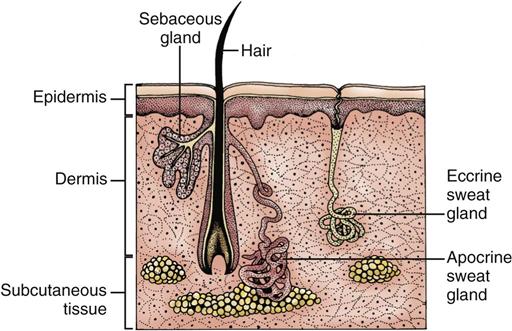
The integumentary system, comprising the skin, hair, nails, and associated structures, is the body’s largest organ system and plays a multifaceted role in maintaining overall health. One of the integral components of this system is the sebaceous gland, a tiny, yet significant, structure that fulfills several vital functions. In this comprehensive article, we will delve into the world of sebaceous glands, exploring their structure, role in the integumentary system, and their impact on skin health.
Anatomy of Sebaceous Glands
Sebaceous glands are microscopic, oil-producing structures found throughout the skin, except on the palms of the hands and the soles of the feet. They are most densely distributed on the face, scalp, chest, and back. These glands are typically connected to hair follicles, and their ducts release their secretions directly onto the hair shaft or, in some cases, onto the skin surface.
Sebaceous glands are composed of specialized epithelial cells that produce and secrete an oily, waxy substance called sebum. Sebum is made up of lipids (fats), cellular debris, and keratinocytes. The consistency of sebum can range from a thin, oily liquid to a thicker, waxy substance.
The Role of Sebaceous Glands in the Integumentary System
Sebaceous glands serve several essential functions within the integumentary system, impacting the health and maintenance of the skin, hair, and nails:
1. Moisturizing and Waterproofing the Skin
Sebum, the oily substance produced by sebaceous glands, acts as a natural moisturizer and waterproofing agent for the skin. It forms a protective film on the skin’s surface, preventing excessive evaporation of water and helping to maintain skin hydration. This is particularly important for preventing dryness and maintaining the skin’s barrier function.
2. Hair Lubrication and Protection
Sebum is released onto hair shafts through hair follicles. It helps lubricate the hair, preventing it from becoming brittle and prone to breakage. Additionally, the oily coating provided by sebum offers some protection against environmental factors like UV radiation and pollutants.
3. Antibacterial and Antifungal Properties
Sebum has natural antibacterial and antifungal properties. Its slightly acidic pH (around 4-5.5) creates an inhospitable environment for harmful microorganisms on the skin’s surface. This helps in preventing skin infections and acne.
4. Thermoregulation
Sebum’s waterproofing properties contribute to the skin’s ability to regulate temperature. By preventing excessive water loss through sweating, sebum assists in maintaining a stable body temperature.
5. Wound Healing
Sebum contains lipids that can aid in the wound-healing process. It helps in preventing excessive moisture loss from the skin at the site of injury, promoting a suitable environment for tissue repair.
6. Skin Health and Appearance
The proper functioning of sebaceous glands is essential for healthy, glowing skin. Balanced sebum production can help prevent skin conditions such as dryness, flakiness, and excessive oiliness. However, overactivity or blockage of these glands can lead to issues like acne and skin congestion.
Sebaceous Glands and Skin Health
While sebaceous glands are essential for skin health, they can also pose challenges when their function is disrupted. Conditions like acne, for instance, are often related to the overproduction of sebum, which can clog hair follicles and lead to the development of pimples, blackheads, and whiteheads.
Conversely, underactive sebaceous glands can result in dry skin, making it more susceptible to damage and infection. Proper skincare, including cleansing, moisturizing, and protection from harsh environmental factors, is essential in maintaining sebaceous gland function and overall skin health.
Conclusion
Sebaceous glands are unsung heroes of the integumentary system, contributing significantly to the health and function of the skin, hair, and nails. Their production of sebum serves multiple purposes, from moisturizing and protecting the skin to providing a natural defense against harmful microorganisms. While sebaceous glands play a pivotal role in maintaining healthy skin, an imbalance in their function can lead to various dermatological issues. Thus, understanding the role of these tiny glands is crucial for effective skincare and overall well-being.



